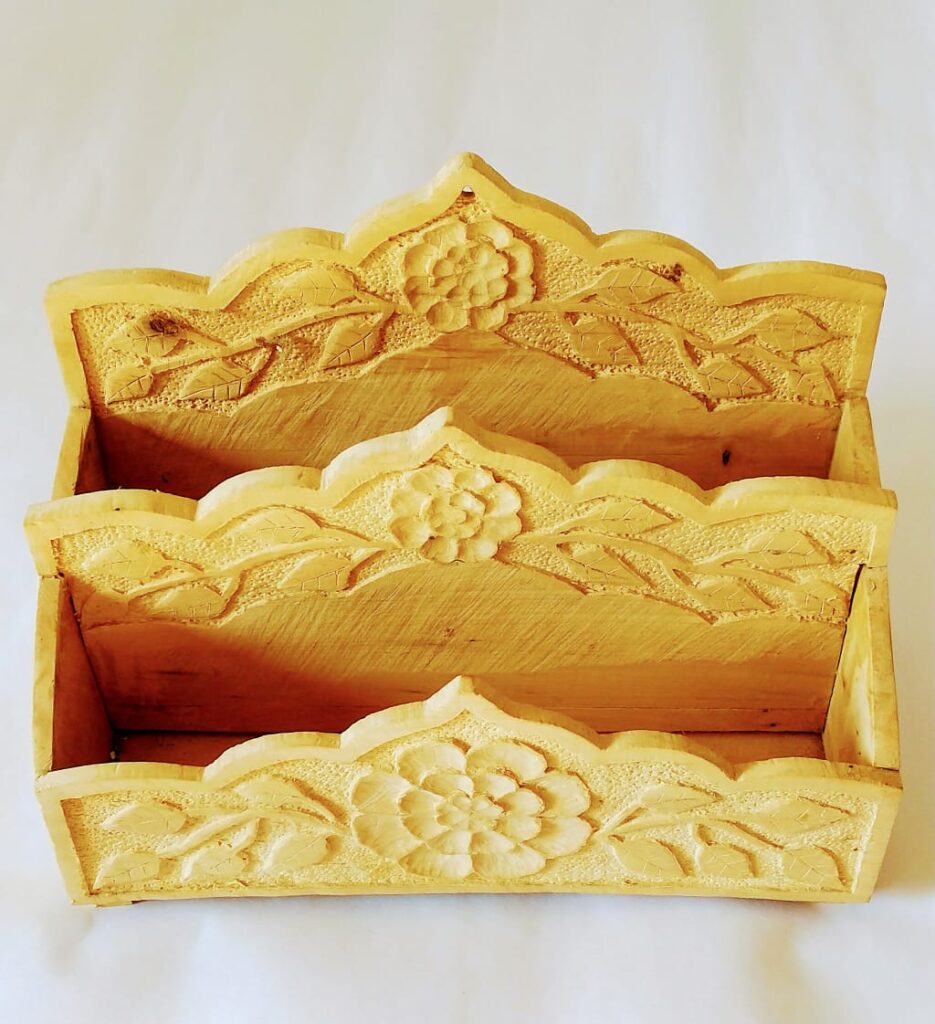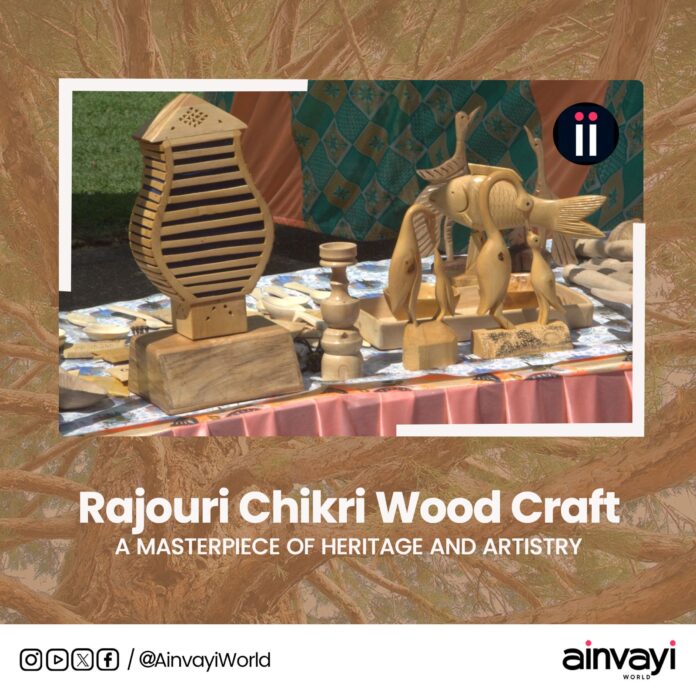A Masterpiece of Heritage and Artistry
Introduction
In the verdant Himalayas of Jammu Division of Jammu and Kashmir, India, lies a craft as alluring as the region itself: Chikri Wood Craft. Deeply rooted in the regional culture, this intricate form of wooden craftsmanship has recently earned the prestigious Geographical Indications (GI) tag, affirming its unique heritage. This milestone invites us to explore its enduring legacy, exceptional artistry, and historical significance.
Geographical Indications Tag
A landmark moment arrived on July 31, 2023, when Chikri Wood Craft became the second handicraft from Jammu Division to be awarded the coveted GI tag. This achievement was made possible through the combined efforts of the Department of Handicrafts & Handloom Rajouri, the Directorate of Handicrafts & Handloom Jammu, and the National Bank For Agriculture And Rural Development (NABARD). The GI registration is held by Rajouri Chikri Wood Handicrafts Industrial Cooperative Limited, Azamatabad Karyot, in Thanamandi tehsil, Rajouri district, protecting its distinct identity under the Geographical Indications of Goods (Registration and Protection) Act, 1999.
Tracing the Legacy
While the exact origins of Chikri Wood Craft remain shrouded in history, it is believed to have existed for well over five centuries, flourishing during the Mughal and Dogra rules with royal patronage. This legacy has provided not only livelihoods, but also encapsulated a way of life, a profound connection to the land, and immense pride for the artisans and locals. It has been handed down through generations, with local artisans preserving ancestral wisdom and techniques.
A spiritual connection to Ziyarat Baba Ghulam Shah Badshah (R.A) Shahdara Sharief, in Thanamandi tehsil, Rajouri district, adds to its mystique, with many artisans believing their craft to be a divine blessing by the holy shrine. The areas around the shrine became centers for this craft, and their location along prominent trade routes helped the craft attract the attention of traders, travelers, and historians. Numerous historical records, Gazetteers, travel writings, research, publications, government documents and media reports, confirm its prominence and celebrate the artistry that continues to thrive today.

The Core of the Craft
At the heart of the Chikri Wood Craft lies the Chikri wood itself, sourced from the Himalayan Boxwood (Botanical name: Buxus wallichiana), a botanical wonder known for its durability, strength, fine texture and resistance to decay. This tree species is found predominantly in the North-Western Himalayas. In Jammu Division, they have been found in Rajouri, Poonch and Reasi districts, and are under the protection of the Forest Department. The species grows slowly, reaching heights of up to 15 meters with evergreen foliage. Their preference for shaded habitats and aversion to direct sunlight contribute to their distinctive growth patterns.
Traditionally, this wood has been valued for its use in local medicine, believed to have plentiful benefits including diaphoretic, anti-rheumatic, vermifuge, antihelminthic, analgesic, purgative diuretic, antiepileptic, antileprotic, and for treating hemorrhoids and promoting hair growth. The wood’s natural warm hues, ranging from light brown to dark chocolate, and its captivating grain patterns, often require no artificial enhancement such as paint or polish, allowing its innate beauty to shine through.
The Art of the Craft
The making of Chikri Wood Craft products is a meticulous process that demands patience, skill and a deep understanding of the wood. The artisans apply time-honored techniques and pay attention to detail to achieve fine luster and intricate designs.
1. Wood Selection and Preparation: The artisans carefully source Chikri wood from the forests for its suitability in carving.
2. Carving and Shaping: Using hand tools, artisans expertly carve and shape the wood into various forms.
3. Sanding and Polishing: The wood is sanded and polished to achieve a smooth, glossy finish.
4. Decorating: The artisans, working entirely freehand, add decorative touches like inlays, motifs, patterns, and engravings, often mirroring local culture, to enhance the final product’s beauty.
5. Assembling: At last, the artisans assemble the components to create the finished product, each of which is a masterpiece in its own right.
Diverse Product Range
Chikri Wood Craft has evolved to include an impressive range of products, many of which are deeply rooted in local traditions. Renowned for their high quality, versatile designs, and affordability, these products have garnered a global customer base over time.
- Combs (Kanghi): The artisans create a wide array of combs with fine teeth and delicate meshwork, which are a timeless favorite among rural, tribal and even the royal women in Jammu and Kashmir. One of the famed varieties is Oil Comb (Tel Wali Kanghi), designed to hold hair-oil for uniform scalp oiling. Another variety stores kohl (surma), where the Chikri wood helps keep it cool. Other prominent varieties are Double-sided Comb, Comb with Mirror (Sheeshe Wali Kanghi), Comb with Nose Pin (Laung Wali Kanghi), offering unique combinations of utility and adornment. It’s said that Mughal Queen Noor Jahan herself used Chikri Wood Combs.
- Wooden Sandals (Khadaun): Known for their comfort, functionality and elegant designs, these sandals are a blend of tradition and artistry.
- Decorative Items: Exquisite jewelry boxes, wall clocks, photo frames, hair clasps, pins, nameplates, toys, combs, baby walkers, showpieces, souvenirs, and customized idols/statues – each adorned with aesthetic patterns—highlight the versatility of Chikri wood.
- Household Goods: Items like spoons, ladles, forks, knives, toothpicks, bowls, cups, jars, pen stands, candle stands, incense stands (agarbatti stands), trunks, hangers, hand blenders, mortar-pestle (khal-musal), rolling pin-board (chakla-belan), and ashtrays as well as furniture like almirahs, centre tables, cot beds, dining tables, diwans, sofa sets, doors, windows, and chairs, are some of the products, combining beauty with functionality, that have gained popularity.
A Living Heritage
Chikri Wood Craft stands as both a living piece of cultural heritage and an economic asset for the Jammu Division and India as a whole. This craft is a testament to the creativity and perseverance of the artisans who continue to breathe life into this centuries-old tradition despite the hardships they face – difficulties in sourcing raw materials and meeting industry demands, limited market exposure and economic viability, lack of awareness, inadequate promotion, waning interest of the younger generation, and competition from cheap alternatives. However, the newfound recognition and the GI tag brings with it a hope of bright future, while increasing the responsibility for both the government and society to safeguard its authenticity, ensure its promotion, and support the artisans in keeping this remarkable craft alive.




